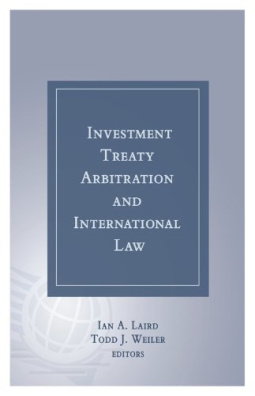Zařazeno v kategoriích: ZAHRANIČNÍ LITERATURA
Investment treaty arbitration and international law
Laird, Weiler
Formát
16x23cm
ISBN
978-1-933833-62-0
EAN
9781933833620
IHNED K ODESLÁNÍ
With this third volume of our series on formative issues in investment law and arbitration, our latest group of talented, young authors continues to meet the high standards set by their predecessors. In the Spring of 2009, our authors met with an experienced cast of discussants to delve deeply into four pressing topics which remain every bit as relevant today, as the 2010 conference date approaches. Either of the first two topics, canvassed herein, could form the basis of a formidable manuscript. The first goes to the very nature of the international commercial arbitration model, as a means of dispute settlement for public international law issues involving State responsibility and the protection of foreign investment. The concept of consent is fundamental to international arbitration, but it can be elusive in practice. It is one thing to consent to the settlement of some future class of disputes in the abstract, upon signing the contract or implementing the treaty, but quite another when the day of disagreement arrives. The customary international law rules of treaty interpretation have evolved over many years so as to provide two or more States with a coherent and reliable means of construing the terms they chose when negotiating an agreement, despite the inherent contradiction that exists in giving binding, legal force to words of diplomacy, which are inherently vague by nature. In the first section, below, our authors and panelists have added their respective contributions to better understanding the jurisdictional nexus between consent and treaty interpretation. In the second section, an issue is confronted that arguably lurks beneath all regulatory impairment claims: the question of whether and if so, how deference should be accorded to measures and the officials who supply and enforce them. Our authors tackle this topic using the lens of the European Community Law concept of margins of appreciation. As investment treaty tribunals proliferate, and the topics the address turn from traditional expropriation claims to regulatory impairment claims, the question of whether a margin of appreciation should be observed will likely grow even more pressing. The third section of this book contains contributions on a topic that is new to investment arbitration, albeit the concept is not uncommon within the municipal context: moral damages. While some treaty provisions expressly preclude tribunals from issuing an award on the grounds of moral damages, the very existence of cases in which moral damages have been awarded demonstrates the heterogeneity of the treaties under which investment treaty arbitrations take place. The fourth section of this book arises from the that same fact of heterogeneity amongst treaty obligations, as well as the mechanisms for dispute settlement they contain. Arbitration is not ideally suited to serve as the basis for articulation and reinforcement of a set of binding norms. It is not intended for the production of rudiments for establishing some sort of common law of international investment. Rather, international arbitration is intended to provide an efficient, fair and binding means of resolving an isolated dispute between the parties to the arbitration, and only those parties. This final session of the 2009 conference was dedicated to better understanding expectations that have arisen for the conduct of investment treaty arbitration, on a systemic level. Does it matter when two tribunals, seized of similar facts and authorised under similar treaty provisions, come to different conclusions? Do different conclusions have a deleterious impact upon the legitimacy of the system itself? The answer would appear to be that just as beauty lies in the eyes of the beholder legitimacy lies in whatever expectations are held for the successful operation of an investment treaty
Ostatní s tímto titulem kupují:
-
Položka byla přidána do košíku.
























